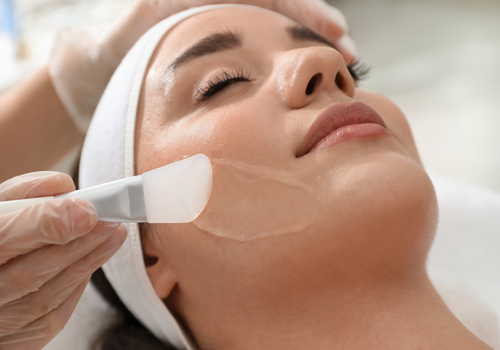
Peeling means peeling the skin using various methods. This peeling is done with chemical solutions, fruit acids, enzymatic methods, It is done by microdermabrasion or laser. With appropriate peeling methods selected for each person, controlled skin removal is achieved at desired depths in the upper and deeper layers of the skin. Damage is created.
Chemical peeling:
Its history dates back to Ancient Egypt. Controlled application of one or more chemical peeling agents to the skin. It is the process that causes regeneration after first destruction in the skin layers by creating a wound. It is divided into three types according to the depth of the effect: superficial, medium and deep.
How does superficial chemical peeling work?
In superficial peeling, the suitability of a mixture consisting of fruit acids such as glycolic acid, pyruvic acid, citric acid, lactic acid, malic acid, tartaric acid and acids such as salicylic acid and resorcinol is applied to the skin surface, depending on the individual. . Controlled effect on the skin By causing damage, superficial lesions on the skin are peeled off, making the skin look younger. It is intended to be seen. Additionally, it tightens the skin and reduces superficial lines and wrinkles.
The result of the operation; It may vary depending on the preparation of the skin for treatment, skin type (color, thickness), concentration of the chemical solution used, application method, and contact time.
For what purposes is superficial peeling used?
- Skin looks bright, taut and plump
- Pore tightening
- Treatment of dark spots and freckles on the skin
- Treatment of acne and scars
- Superficial scars
Preparation of the skin:
It is important to prepare the skin to reduce the side effects that may occur after peeling and to maximize the peeling results. Various creams recommended to you by your doctor should be applied at least 1 month in advance.
After peeling:
Since most patients will feel their skin dry and tight after the application, they should use gentle cleansers and moisturizers. In the first 24 hours, mild edema, redness, burning/stinging sensation and itching are observed on the skin. After 48 hours, the redness is replaced by slight darkening and peeling of the skin. Recovery after application is observed within 2-7 days. Patients can return to skin care products when the peeling symptoms disappear. Protection should be provided with a sunscreen of at least SPF 30 every 2-3 hours after the treatment.
What is the Transaction? Should a session be held?
Although session intervals vary depending on skin type and type of skin problems, 6-8 sessions are recommended on average every 1-2 weeks. The number of sessions, concentration and the time the peeling stays on the skin depend on the reaction of the skin in each session. is increased.
How does medium chemical peeling work?
It activates the repair mechanisms under the skin by creating a burn warning under the skin, and by stimulating the repair mechanism under the skin, the production of collagen and elastic fibers is triggered. Thus, a revitalization and rejuvenation of the skin; With the slight peeling of the skin, it becomes more spotless, A lively, bright skin is formed. Application can be done on the neck and hands as well as the face. The most frequently used TCA peelings are 70% glycolic acid and 10-35% concentration.
Medium Chemical Peels;
*Signs of skin aging due to severe and moderate sun damage,
*Skin color inequalities
*For deeper wrinkles and sagging skin,
*Actinic keratosis (pre-cancerous lesions on the skin that occur with age and after chronic sunlight exposure)
*Acne scars
*Reduction of fine lines and wrinkles
*Healing period: Redness and peeling on the skin disappear in 1 week, session intervals should not be less than 1 month. After the treatment, protection should be provided with a sunscreen of at least SPF 30 every 2 hours. One should not pick the peels during peeling and should not use any peeling treatments such as retinoic acid. It is recommended to avoid practices such as hot showers, baths and scrubs.
*While superficial changes are observed in the early period with the renewal of the patient's skin after peeling, the effects in deeper tissues begin in 1-2 weeks and since the remodeling of collagen can take months, it takes exactly 1-3 months. It emerges within.


